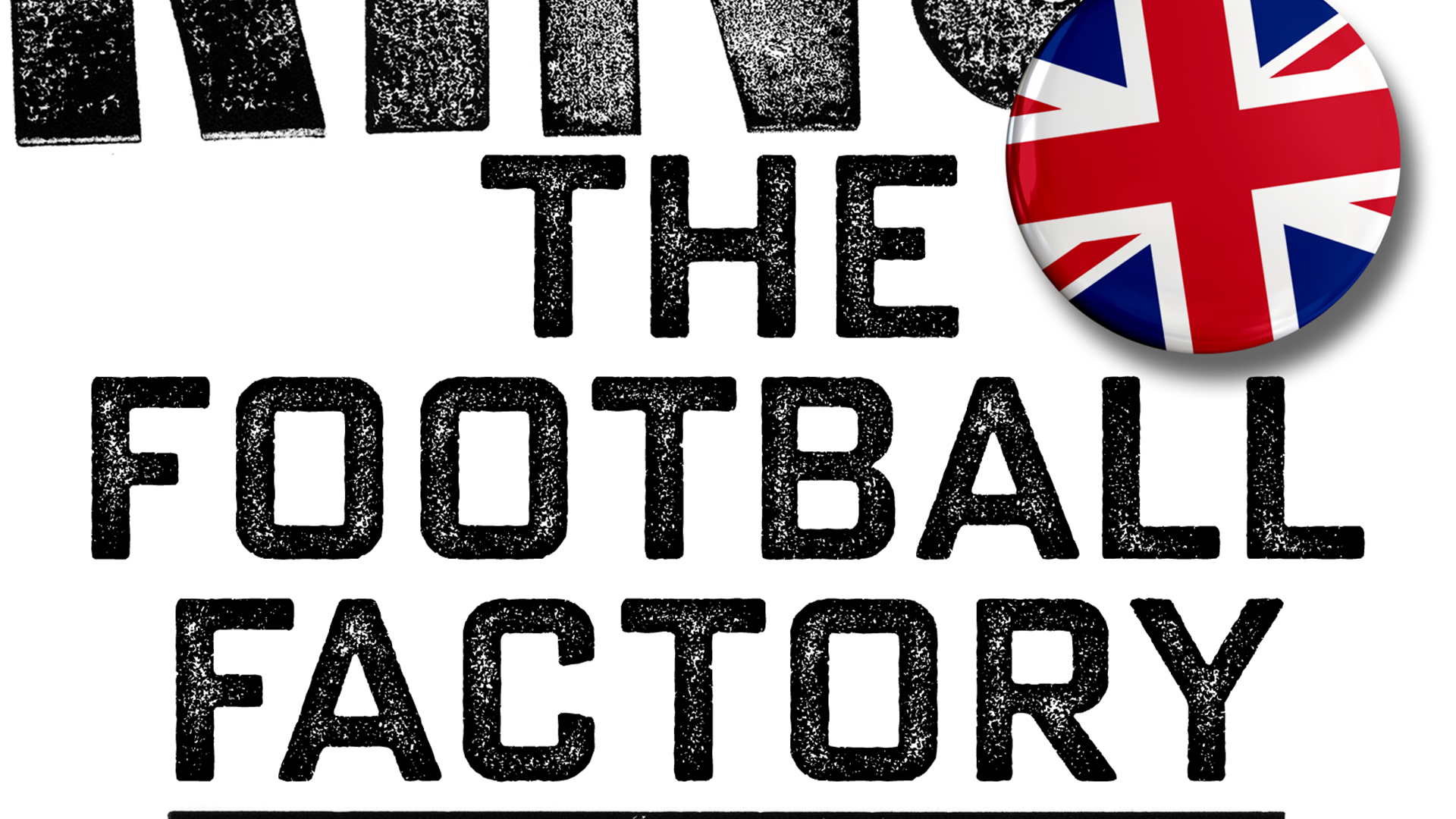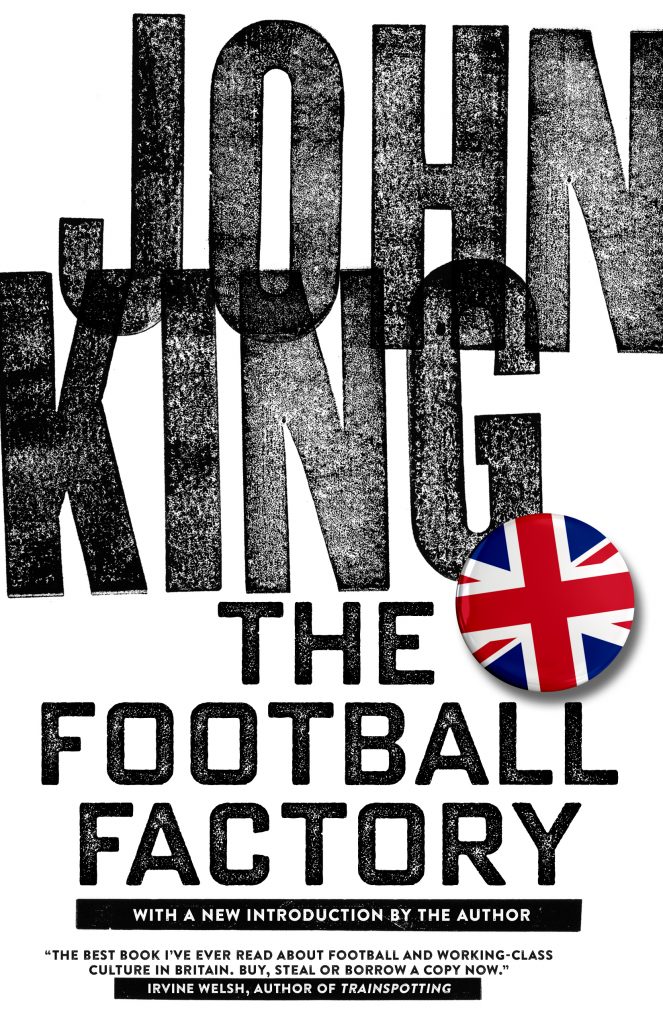Originally published in Abaddon # 2, Autumn 1999.
The Football Factory, John King’s début novel, charts the lives of a group of football hooligans in present-day London, England. It has been re-issued to coincide with the release of England Away, King’s most recent book and the third part of his loose trilogy (Headhunters was the second). Although The Football Factory is an important work, it has not had much critical attention in Australia, with ‘soccer’ not considered to be a particularly marketable subject here. This review will attempt to redress the imbalance and whet your appetite for John King’s skilful œuvre.
In case you’re wondering, The Football Factory is not ‘science fiction’ or ‘fantasy.’ In fact, most would class it as straight realism, punk-as-fuck and no-holds barred. But don’t be fooled by the Irvine Welsh endorsement on the cover. King writes about working class mores, football and drugs, less the sloppiness and incomprehensible self-indulgence peddled by the Scottish writer.
Still, the question remains: why is King getting props in a magazine ostensibly concerned with the ‘fantastic’?
In the last issue of Abaddon, Andrés Vaccari briefly attempted to sketch out a future direction for science fiction. Stating that the major challenge facing the genre is a meaningful examination of the present, Vaccari argues that SF “has not successfully engaged with some dominant (and curiously ‘science fictional’) languages of our era: the languages of advertising [and] propaganda…”
This is precisely the focus of The Football Factory, with King fictionalising the bewildering experience of living within a literalised media landscape and the resultant pre-millennium tension. The book does not speak science fiction – it lives it, in everyday life.
Tom Johnson is young, good looking, well dressed, quick-witted: the antithesis of the stereotypical football yob. A Chelsea supporter, Tom brawls his way around England’s Premier League grounds, scoring cheap and nasty sex along the way.
The Football Factory consists of self-contained chapters, mostly told from Tom’s point of view, his internal monologues ruminating at length upon the nature of the modern British police state. In King’s London, surveillance cameras record, edit and wipe over lives with clinical efficiency; the economical, tight prose (aided by the book’s disjointed narrative structure) zooms in on each character, filing their personal details for later reference and further developments.
While Tom lives for the moment, for the adrenalin rush of the ruck, his crew don’t do their brawling inside the heavily policed grounds, but outside, away from the crowds. King sets this milieu up as a Temporary Autonomous Zone, with the fighting (a consensual act, directed through the primacy of the thrill of the chase) moving from ground to ground, always reforming and uprooting itself when authority nears. Rival firms stalk the streets, sniffing each other out, all with ultra-violence on their minds, their strategic intelligence ensuring they are one step ahead of the inefficient police. It could have been a clumsy dichotomy, but the point is subtle and well-made: for Tom, the fighting is a release from the drudgery of his factory job and from the mind-numbing monotony of consumer society. But King never preaches, his writing is never heavy-handed, and therein lies the book’s strength – the slow-creeping atmosphere is oppressive for the manner by which it is so thoroughly masked from view.
Note the references to the Daliesque quality of our late-capitalist dystopia: a character’s realisation that only 12-and-a-half per cent of money physically exists, the rest “just numbers in computers”; a flashback in which Tom, as a child, puzzles over the fact that “they just have to make a law and [Dad] has to pay what they say otherwise he goes to prison”; a self-contained chapter in which Vince Matthews, an ex-hooligan who has renounced his violent past and now spends his time withdrawn into his skull, sits in an Indian cafe, nursing a bang lassi and agonising over a game of chess with the proprietor.
Vince’s drug-addled thoughts turn from the game to a reflection on the multi-cultural nature of British society. In his skinhead days, Vince used to witness London race riots fuelled by political portrayals of minority ethnic groups as meek and unrepresented. But, he reflects, the reality is very different, the Indian flavour of his surrounds constituting a state-without-borders: “I know that from growing up in the area … you’re living in the real world, not some whitewashed Tory idea of a constipated paradise or socialist ideal of good-natured underdog, just people, that’s what it is, just people … it’s all about clear thinking and seeing beyond the initial action, making the right decision when there are so many different versions of the truth … there must be something in this lassi because I’m having trouble keeping my thoughts together, pulling the different strands tight adjusting the contradictions, like the information has got tangled together and my brain is being squeezed by the rush of images…”
For King, London is a template for the postmodern world: a contradictory, dazzling mix of old and new, rich and poor, black and white, high-tech versus Edwardian grit; an urban sprawl with no definable centre; an infinite play of surfaces in which myths and artificial realities abound. One chapter moves away from Tom’s point of view, exploring a day in the life of a tabloid football journalist as he explains the tricks of his trade. When writing about hooliganism, the ‘English Disease’, the reporter notes: “First comes the titillation and gory details, then the condemnation which masks the pleasure the reader’s had from the story. Call for the return of the cat o’nine tails and demand some good old fashioned square-bashing and everyone’s happy. It makes the public feel secure.”
Another chapter examines a social worker and her vested interest in rehabilitating hooligans such as Tom: “Michelle could find no logic in drugging yourself up to the eyeballs and ignoring the realities of life … These football hooligans she’d read about were avoiding the issues, kicking lumps out of each other over a sport. It was unbelievable. Sport was the ultimate indignity of a capitalist society, resting as it did on the importance of competition, the wastage of resources, concentrating people’s energies away from the class struggle towards silly games. She had never been to a football match herself, though she had listened to gutter conversations in her local, but felt qualified to comment.”
But Tom, dismissive of these “rich cunts and slumming socialists”, is the key. Shaped and moulded by competing forces to suit varying agendas, he’s rewritten as hero, thug, sex symbol, as noble savage. He is – to all intents and purposes – a digital ghost wandering the nooks and crannies of the media landscape, police surveillance cameras perpetually on his case. Kicking and fucking his way relentlessly, Tom wills pain into his body, wallowing in his physicality – a crucial strategy in the fight to breathe life once again into his disembodied self.
At one point, Tom expresses an admiration for the films Clockwork Orange and Blade Runner, and there are obvious parallels between the former and King’s book. When Stanley Kubrick filmed Clockwork Orange, he withdrew it from circulation a few years later on the grounds that real-time British society was far more shocking than his depiction. King appears to confirm Kubrick’s paranoia. In many ways, The Football Factory is Clockwork Orange updated, with Tom and his mates serving the same function as Alex and his droogs – all commit vicious acts as a reaction against their sterilised environment.
King is obsessed with the same philosophical conundrum as Anthony Burgess was (the author of Kubrick’s source novel): simply, is the freedom to commit violence an acceptable by-product of freedom of choice? What is the alternative? Does the state have the moral right to regulate acts of violence when those acts constitute authentic free will?
And King writes with enough skill to help us to share Tom’s adrenalin high. The fight scenes are as addictive as anything I’ve known; combined with the author’s laser-sharp intelligence and considered political perspective, and the effect is overwhelming.
Including Burgess, The Football Factory echoes George Orwell’s 1984 as well as polemical films from Lindsay Anderson (If….) and Peter Watkins (Privilege) – all express bitter loathing for the rotting corpse of British democracy. King’s firm root in the present day, through use of language and setting, does not distance The Football Factory from these earlier, nominally science fictional texts; it fulfils their prophecies.
Science fiction is dead: the future is now.







